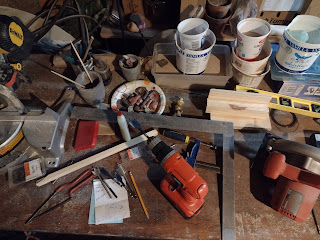Hello Box Bellows
We were looking at different kinds of bellows that we might use to get higher temperatures in our bronze clay furnace. And in the end we decided on box bellows. It seemed like it would be fun to build, within our woodworking abilities, and also provide enough air. We also liked how they were rather a different design than the accordion or bucket bellows that we thought were more typical.
In essence, it's a box with a piston that draws air in and out, and inlets with flaps that allow the air to flow down and out by the path of least resistance through a tube or nozzle (tuyère) at the bottom. The end of that nozzle is in your furnace or forge.
Our bellows is made out of pine.
An old vacuum cleaner tube serves as the tuyère.
Here are the holes for both ends of the box.
All the holes get covered with a heavy fabric flap, which forces the air to go in but not back out when you draw the piston out.
 |
| lower hole with flap |
It was great fun to wrestle with all the seemingly simple things that come up when making a "box with a platform and some flaps." It would take me hours to make a few cuts and glue some pieces together, and I knew someone with experience could have made the whole bellows in that time. It's not often you get to feel yourself learning. So I relish these kinds of side projects of the Fire Craft.
Next up was making the piston. An old broom handle for the shaft, and a hole through it for the pin.
 |
| temporary short platform in there, for testing |
I looked forward to using these manual bellows. I figured the experience of pushing and pulling for who knows how long would really add to the experience of trying to alloy bronze. It would be a way of travelling through time, in order to experience time as ancient metal-workers did, from the earliest of days up to the Industrial Revolution. Time as experienced through the weariness of muscle, and the drudgery of (mindless?) repetition.
It's hard to see but the red arrows point beneath the platform that the piston runs along. Under the platform there are two struts with holes with flaps, and as the air gets pushed down below the platform, it flows through the flaps and is forced out the nozzle at the side. Here it is, all done.
It's not exactly a how-to, but here's a video:
But a how-to that we did find useful is here.


















Comments
Post a Comment